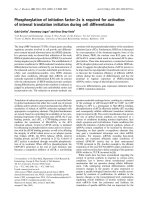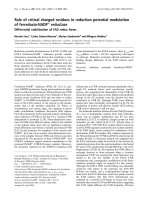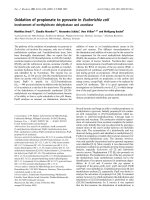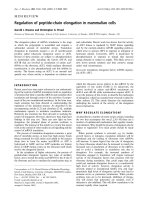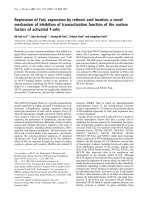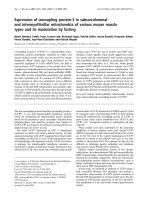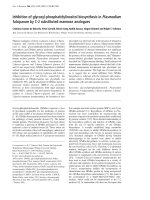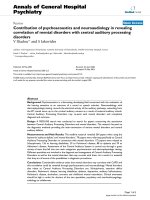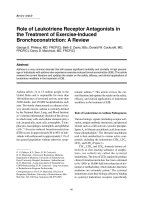Báo cáo y học: "Repression of anti-proliferative factor Tob1 in osteoarthritic cartilage" pps
Bạn đang xem bản rút gọn của tài liệu. Xem và tải ngay bản đầy đủ của tài liệu tại đây (674.71 KB, 11 trang )
Open Access
Available online />R274
Vol 7 No 2
Research article
Repression of anti-proliferative factor Tob1 in osteoarthritic
cartilage
Mathias Gebauer
1
*, Joachim Saas
2
*, Jochen Haag
3
, Uwe Dietz
2
, Masaharu Takigawa
4
,
Eckart Bartnik
2
and Thomas Aigner
3
1
Aventis Pharma Deutschland, Functional Genomics, Sanofi-Aventis, Frankfurt, Germany
2
Sanofi-Aventis, Disease Group Thrombotic Diseases/Degenerative Joint Diseases, Frankfurt, Germany
3
Osteoarticular and Arthritis Research, Department of Pathology, University of Erlangen-Nürnberg, Germany
4
Department of Biochemistry and Molecular Dentistry, Okayama University Graduate School of Medicine and Dentistry, Okayama, Japan
* Contributed equally
Corresponding author: Thomas Aigner,
Received: 10 Aug 2004 Revisions requested: 1 Oct 2004 Revisions received: 22 Oct 2004 Accepted: 19 Nov 2004 Published: 11 Jan 2005
Arthritis Res Ther 2005, 7:R274-R284 (DOI 10.1186/ar1479)
http://arthr itis-research.com/conte nt/7/2/R274
© 2005 Gebauer et al.; licensee BioMed Central Ltd.
This is an Open Access article distributed under the terms of the Creative Commons Attribution License ( />2.0), which permits unrestricted use, distribution, and reproduction in any medium, provided the original work is properly cited.
Abstract
Osteoarthritis is the most common degenerative disorder of the
modern world. However, many basic cellular features and
molecular processes of the disease are poorly understood. In
the present study we used oligonucleotide-based microarray
analysis of genes of known or assumed relevance to the cellular
phenotype to screen for relevant differences in gene expression
between normal and osteoarthritic chondrocytes. Custom made
oligonucleotide DNA arrays were used to screen for differentially
expressed genes in normal (n = 9) and osteoarthritic (n = 10)
cartilage samples. Real-time polymerase chain reaction (PCR)
with gene-specific primers was used for quantification. Primary
human adult articular chondrocytes and chondrosarcoma cell
line HCS-2/8 were used to study changes in gene expression
levels after stimulation with interleukin-1β and bone
morphogenetic protein, as well as the dependence on cell
differentiation. In situ hybridization with a gene-specific probe
was applied to detect mRNA expression levels in fetal growth
plate cartilage. Overall, more than 200 significantly regulated
genes were detected between normal and osteoarthritic
cartilage (P < 0.01). One of the significantly repressed genes,
Tob1, encodes a protein belonging to a family involved in
silencing cells in terms of proliferation and functional activity.
The repression of Tob1 was confirmed by quantitative PCR and
correlated to markers of chondrocyte activity and proliferation in
vivo. Tob1 expression was also detected at a decreased level in
isolated chondrocytes and in the chondrosarcoma cell line
HCS-2/8. Again, in these cells it was negatively correlated with
proliferative activity and positively with cellular differentiation.
Altogether, the downregulation of the expression of Tob1 in
osteoarthritic chondrocytes might be an important aspect of the
cellular processes taking place during osteoarthritic cartilage
degeneration. Activation, the reinitiation of proliferative activity
and the loss of a stable phenotype are three major changes in
osteoarthritic chondrocytes that are highly significantly
correlated with the repression of Tob1 expression.
Keywords: bone morphogenetic protein, cartilage, chondrocytes, gene expression, proliferation
Introduction
Osteoarthritis is the most common disabling condition of
humans in the western world. Although osteoarthritis is
mainly a disease and functional loss of the articular carti-
lage covering the joint surfaces, it is clearly the cells that are
the active players during the disease process [1]. What-
ever pleomorphisms the cellular reaction patterns display at
first sight during the osteoarthritic disease process, they
can be basically summarized in three categories (reviewed
in [2]). First, the chondrocytes can degenerate or prolifer-
ate. Second, chondrocytes can activate or deactivate their
synthetic anabolic or catabolic matrix-degrading activity by
increasing or decreasing anabolic or catabolic gene
expression. Last, chondrocytes can undergo phenotypic
modulations implicating an overall severely altered gene
expression profile of the cells in the diseased tissue. In fact,
several distinct phenotypes of chondrocytes are known to
occur in vitro, in vivo during fetal development and
BMP = bone morphogenetic protein; cDNA = complementary DNA; cRNA = complementary RNA; IL = interleukin; MMP = matrix metalloproteinase;
PBS = phosphate-buffered saline; PCR = polymerase chain reaction; qPCR = quantitative polymerase chain reaction; UTR = untranslated region.
Arthritis Research & Therapy Vol 7 No 2 Gebauer et al.
R275
potentially also in the disease process itself, but new mark-
ers are required for the more accurate characterization of
cellular behavior [3]. This will allow further analysis of the
underlying pathology to develop therapeutic approaches
that could delay, stop, or even reverse cartilage
degeneration.
In many laboratories single and multiple gene analyses
have been performed on normal and osteoarthritic cartilage
specimens; however, a global overview of disease-associ-
ated changes is not available. This highlights the need for
establishing a broader gene expression profile of osteoar-
thritic chondrocytes by modern screening technologies so
as to characterize more properly the cellular events and
regulatory pathways directly involved in cartilage destruc-
tion. In the present study, we designed a custom-made oli-
gonucleotide-based microarray to screen for differentially
expressed genes in normal and osteoarthritic cartilage
specimens. We found that Tob1, a gene involved in cell
cycle regulation and cell quiescence [4,5], was significantly
repressed in osteoarthritic chondrocytes. This was con-
firmed by quantitative polymerase chain reaction (qPCR)
and further analyzed in adult articular chondrocytes in vitro
and in vivo.
Materials and methods
Donors for mRNA expression analysis
For the study of mRNA expression levels within the tissue,
cartilage from human femoral condyles of normal knee
joints was used. Normal articular cartilage (n
qPCR
= 10, age
range 45–88 years, mean age 64.1 years; n
array
= 9, age
range 37–83 years, mean age 59 years) was obtained from
donors at autopsy, within 48 hours of death. Osteoarthritic
cartilage samples from late-stage osteoarthritic joint dis-
ease were obtained from patients undergoing total knee
replacement surgery (n
qPCR
= 15, age range 63–85 years,
mean age 74.5 years; n
array
= 10, age range 57 to 84 years,
mean age 76 years). The cartilage was frozen in liquid nitro-
gen immediately after removal and stored at -80°C until
required for RNA isolation.
Cartilage was considered to be normal according to a mac-
roscopic scoring system of the opened joint: this mainly
included normal synovial membrane, normal synovial fluid,
no significant overall softening or surface fibrillation (except
on the tibial plateau, which is basically found in all speci-
mens depending on age). The Mankin's grade of histologi-
cal plugs taken was less than 3. Osteoarthritic cases
fulfilled the criteria published by the American College of
Rheumatology [6]. Cases of rheumatoid origin were
excluded from the study.
Isolation of primary human articular chondrocytes;
stimulation with interleukin (IL)-1β and bone
morphogenetic protein (BMP)-7
Normal human knee articular cartilage was obtained from
six normal cases at autopsy within 48 hours of death. Car-
tilage pieces were finely chopped and chondrocytes were
isolated enzymatically as described previously [7].
Chondrocytes were either plated in high-density monolayer
cultures or cultured in alginate beads. Cultures were main-
tained for 48 hours in serum-free Dulbecco's modified
Eagle's medium/F12 medium (Gibco BRL, Eggstein, Ger-
many) supplemented with 1% penicillin/streptomycin solu-
tion (Gibco BRL) and 50 µg/ml ascorbate (Sigma,
Taufkirchen, Germany) and 10% fetal calf serum (Bio-
chrom, Berlin, Germany).
After 48 hours, primary (non-passaged) chondrocytes were
stimulated with 1 ng/ml IL-1β (R&D System, Minneapolis,
MN, USA) in DMEM/F12 medium, 100 ng/ml recombinant
human BMP-7 (Stryker Biotech, Hopkinton, MA, USA) or
cultivated in medium alone for 24 hours with no medium
change afterwards. The same experiments were performed
in parallel in the presence and in the absence of 10% fetal
calf serum. At the end of the culturing/stimulation period
the cells were washed in sterile phosphate-buffered saline
(PBS), lysed in 350 µl of lysate RLT buffer/10
6
cells and
stored at -80°C.
Culture of HCS-2/8 cells
The human HCS-2/8 chondrosarcoma cell line (around
passage 50–55) [8,9] was cultured in DMEM (PAA, Linz,
Austria) supplemented with 20% fetal bovine serum (Gibco
BRL) and with 50 µg/ml ascorbate (Sigma) in a humidified
atmosphere of 5% CO
2
at 37°C as described [9]. Cells
were seeded at 10
5
cells/cm
2
and grown for 3 days to
obtain subconfluent stage cultures, at 2 × 10
5
/cm
2
and cul-
tured for 7 days to obtain confluent stage cultures, and at
6 × 10
5
/cm
2
and grown for 10 days for over-confluent
stage cultures.
RNA isolation from articular cartilage and isolated
articular chondrocytes
Total RNA from both cartilage tissue and isolated chondro-
cytes was isolated as described previously [10,11]. The
quality of total RNA samples was checked by agarose-gel
electrophoresis and with the Bioanalyzer RNA 6000 Nano
assay (Agilent, Waldbronn, Germany).
Construction of the SensiChip cartilage microarray
The SensiChip technology is a two-color microarray plat-
form using the Planar Wave Guide technology for microar-
ray detection [12], which increases signal-to-noise ratios
and thereby the sensitivity of hybridization experiments. The
arrays were spotted in duplicate with 70-mer oligonucle-
otides representing the 3' untranslated region (UTR) of
Available online />R276
about 340 human cartilage-relevant genes, whereas one
single gene was represented by one 70-mer
oligonucleotide.
Expression profiling with the SensiChip two-color DNA-
microarray platform
Total RNA (250 ng) from osteoarthritic cartilage (10 sam-
ples) and pooled normal cartilage was amplified and
labeled with Cy3-UTP and Cy5-UTP respectively (Amer-
sham Pharmacia) using the MessageAmp aRNA kit
(Ambion). After clean-up of the complementary RNA
(cRNA) with the RNeasy kit (Qiagen), 5 µg of Cy3-labeled
cRNA from osteoarthritic cartilage was mixed with 5 µg of
Cy5-labeled cRNA from pooled normal cartilage. cRNA
was fragmented by incubation with 40 mM Tris-acetate, pH
8.1, 100 mM potassium acetate, 30 mM magnesium ace-
tate for 15 min at 95°C and desalted with a Microcon YM-
10 concentrator (Millipore). Mixed Cy-dye labeled cRNA
samples (600 ng) were hybridized for 16 hours on a Sensi-
Chip microarray (Qiagen) spotted in duplicate with 70-mer
oligonucleotides representing the 3' UTR of selected
genes. The gene-specific oligonucleotide sequences were
designed by Operon by using GenBank accession num-
bers and proprietary algorithms. After washing steps per-
formed in accordance with the manufacturer's standard
protocol, arrays were scanned with the SensiChip Reader.
The resulting array images were analyzed with SensiChip
View 2.1 software (Qiagen) to quantify gene-specific signal
intensities.
For quality control of RNA labeling and hybridization effi-
ciency, oligonucleotides representing human housekeep-
ing genes, negative and external bacterial spiking controls
were also included. These sequences were prelabeled with
fluorescent Cy3 and Cy5 dyes, and mixed in different con-
centrations into the hybridization solutions containing the
labeled cRNA samples from human cartilage.
Expression data analysis
All microarray scans were inspected visually and checked
for quality on the basis of the performance of negative,
housekeeping and externally added Cy3/Cy5-prelabeled
spiking controls. Raw signal intensities from each scan
were imported into the gene expression analysis software
Resolver version 4.0 (Rosetta Biosoftware, Seattle, WA,
USA). The software employs an error-modeling approach
for the analysis of microarray data [13]. An error model spe-
cific for the SensiChip microarray platform was designed
by Rosetta Biosoftware based on expression data from
repeated hybridizations of the same RNA material to deter-
mine the variation of signal intensities. A complete descrip-
tion of the statistical methods used is available in the
technology section of the Rosetta Biosoftware website
/>.
All scans were pre-processed and normalized with the Sen-
siChip error model to calculate P values and error bars for
every gene expression profile. The P value represented the
probability that an observed gene regulation was due to a
measurement error. Gene regulation was considered as
statistically significant if the calculated P value was below
a threshold of 0.05. For normalization of expression data,
the average brightness of the Cy3 and Cy5 channels
respectively was used that was calculated from spots
within a range from 30% to 85% of the signal intensity dis-
tribution of all spots. Scans from multiple experiments (rep-
licates) were combined by averaging expression data with
an error-weighted algorithm (also described in the statisti-
cal methods document available on the Rosetta Biosoft-
ware website).
Real-time quantitative PCR using TaqMan technology
Real-time PCR was used to detect human Tob1, collagen
type II, Ki-67, matrix metalloproteinase (MMP)-13 and
glyceraldehyde-3-phosphate dehydrogenase mRNA
expression levels in human articular cartilage RNA samples.
The primers (MWG Biotech, Ebersberg, Germany) and
TaqMan probes (Eurogentec, Liège, Belgium) were
designed using Primer Express™ software (Perkin Elmer).
To be able to obtain quantifiable results for all genes, spe-
cific standard curves using sequence-specific control
probes were performed in parallel to the analyses. Thus, for
each gene a gene-specific cDNA fragment was amplified
by the gene-specific primers (Table 1) and cloned into
pGEM T Easy (Promega, Mannheim, Germany) or pCRII
TOPO (Invitrogen, Karlsruhe, Germany). The cloned ampli-
fication product was sequenced to confirm correct cloning.
Cloned standard probes were amplified with the plasmid
amplification kit (Qiagen), linearized and used after careful
estimation of the concentration (gel electrophoresis, pho-
tometry, and a fluorimetric assay for deoxyribonucleic acids
(Picogreen; Molecular Probes, Eugene, OR, USA)). For the
standard curves concentrations of 10, 100, 1000, 10,000,
100,000, and 1,000,000 molecules per assay were used
(all in triplicate).
For the analyses of the different genes, a separate master
mixture was made up for each of the primer pairs and con-
tained a final concentration of 200 µM NTPs, 600 nM
Roxbuffer and 100 nM TaqMan probe. For all genes the
final reaction mixture contained, besides cDNA and 1 U
polymerase (Eurogentec), forward and reverse primers, the
corresponding probes, and MgCl
2
at concentrations given
in Table 1. All experiments were performed in triplicate.
Immunofluorescence
Immunofluorescence studies were performed on parafor-
maldehyde-fixed paraffin-embedded specimens of normal
(n = 5) and osteoarthritic (n = 5) articular cartilage. Sec-
tions were first incubated with the primary antibodies
Arthritis Research & Therapy Vol 7 No 2 Gebauer et al.
R277
overnight, then with biotin-labeled goat anti-mouse anti-
bodies (Dianova, Hamburg, Germany) and then with perox-
idase-labeled streptavidin (Dianova). Subsequently, the
tyramide amplification system (PerkinElmer, Boston, MA,
USA) was used for signal amplification. Finally, the signals
were detected with Cy5-labeled streptavidin (Dianova).
Nuclear staining was again performed with 4,6-diamidino-
2-phenylindole. The sections were evaluated by a (fluores-
cence) microscope (Olympus AX70) and photographed
digitally.
To obtain optimal staining results various enzymatic pre-
treatments were tested, including hyaluronidase (Boe-
hringer, Mannheim, Germany; 2 mg/ml in PBS pH 5 for 60
min at 37°C), pronase (Sigma, Deisenhofen, Germany; 2
mg/ml in PBS pH 7.3 for 60 min at 37°C), and bacterial
protease XXIV (Sigma; 0.02 mg/ml; PBS pH 7.3 for 60 min
at 37°C). Finally, the mouse monoclonal antibodies against
Tob1 (Assay Designs, Ann Arbor, MI, USA) were used at a
dilution of 1:20 without pretreatment of the sections.
Amplification and cloning of Tob1 cDNA
RNA was isolated from differentiated ADTC5 cells (Ricken
Library) in accordance with the extraction method with Tri-
zol
®
(Invitrogen) and reverse-transcribed into cDNA with
SuperScript II™ reverse transcriptase (Invitrogen) by follow-
ing the manufacturer's recommendation.
PCR amplification of a 607 base pair Tob1 cDNA fragment
(nucleotides 402–1008 of the sequence in GenBank
accession no. NM_009427) was performed with gene-
specific primers (forward, 5'-GGAGCCCCCAGGTGT-
TCATGC-3'; reverse, 5'-CTCGTTGAGGCCTCCGTAGG-
3') by a standard method, and amplification products were
cloned into pCR
®
-BluntII-TOPO
®
vector (Invitrogen).
In situ hybridization
In situ hybridization of sectioned appendicular skeleton
from newborn mice was performed with digoxigenin-
labeled antisense riboprobes transcribed from the Tob1
cDNA fragment. Hindlegs of newborn mice were fixed
overnight in 4% paraformaldehyde resolved in PBS. After
stepwise transfer through solutions with increasing ethanol
concentration, the specimens were incubated in xylene and
finally embedded in paraffin wax.
For in situ hybridization, paraffin-embedded samples were
cut into slices 7 µm thick and mounted on microscope
slides. The sections were hybridized with digoxigenin-11-
UTP-labeled antisense riboprobes, which were transcribed
with T7 RNA polymerase from the Tob1 cDNA fragment
cloned into pCR
®
-BluntII-TOPO
®
(Invitrogen), after lineari-
zation of the plasmid with BamHI.
In situ hybridization was performed as described by Dietz
and colleagues [14]. After detection of hybridization prod-
ucts, the sections were mounted under coverslips in Kai-
ser's glycerol gelatin (Merck) and photographed under a
Zeiss Axioplan 2 microscope.
Results
Construction of the SensiChip cartilage microarray
A microarray covering 340 human cartilage relevant genes
was constructed, where one single gene was represented
by one 70-mer oligonucleotide (Fig. 1a). Most genes were
selected from the literature and have important roles in ana-
bolic or catabolic pathways during osteoarthritis (for exam-
Table 1
Sequences of primers and probes for quantitative real-time polymerase chain reaction
Gene GenBank accession no. Primers (5'→3') Conc. (nM) Probe (5'→3') MgCl
2
(mM)
GAPDH NM_002046 Forward: GAAGGTGAAGGTCGGAGTC 50 CAAGCTTCCCGTTCTCAGCC 5.5
Reverse: GAAGATGGTGATGGGATTTC 900
TOB1 NM_005749 Forward: TCTGCTGCTGTAAGCCCTACCT 300 CGGTCCACTCAGCCTTTAACCTTTACCACT 6.5
Reverse: TTCATTTTGGTAGAGCCGAACTT 900
Ki-67 NM_002417 Forward: CAGTGATCAACGCCGTAGGTC 900 CTTCCAGCAGCAAATCTCAGACAGAGGTTC 6.0
Reverse: TCGGCTGATAGACACTCTCTTTTG 900
COL2A1 NM_001844 Forward:CAACACTGCCAACGTCCAGAT 50 ACCTTCCTACGCCTGCTGTCCACG 5.5
Reverse: CTGCTTCGTCCAGATAGGCAAT 300
MMP-13 NM_002427 Forward: TCCTCTTCTTGAGCTGGACTCATT 900 TCCTCAGACAAATCATCTTCATCACCACCAC 7.0
Reverse: CGCTCTGCAAACTGGAGGTC 50
GAPDH, glyceraldehyde-3-phosphate dehydrogenase; MMP, matrix metalloproteinase; COL2A1, collagen type II (alpha 1 chain); TOB1,
Transducer of ERBB2.
Available online />R278
ple, cartilage matrix proteins such as collagens, relevant
degrading enzymes such as MMPs and aggrecanases, and
genes from important catabolic [IL-1, tumor necrosis fac-
tor-α] and anabolic [BMP, transforming growth factor-β]
signaling pathways).
Gene expression analysis: differentially expressed
genes
Total RNAs from 10 late-stage osteoarthritic cartilage sam-
ples were hybridized separately against a pool of mixed
total RNAs from nine normal cartilage donors on the cus-
tomized SensiChip microarrays. Merging of expression pro-
files obtained from all 10 late-stage osteoarthritic cartilage
samples used for hybridizations resulted in about 200 sig-
nificantly regulated genes that were differentially expressed
between normal and osteoarthritic cartilage, with P < 0.01
(Fig. 2 and Table 2; the whole data set is in Additional file
1).
Tob1 is repressed in osteoarthritic chondrocytes
One of the differentially expressed genes was the human
transducer of ERBB2,1 (Tob1; GenBank accession no.
NM_005749). Tob1 was transcriptionally downregulated
in all 10 human osteoarthritic cartilage samples to, on aver-
Table 2
Table showing genes which were upregulated or downregulated in osteoarthritic chondrocytes (changes in mRNA expression levels
>2-fold; P < 0.01)
Downregulated genes GenBank
accession no.
OA:N OA N Upregulated genes GenBank
accession no.
OA:N OA N
CHI3L1 NM_001276 0.02 0.001 0.05 COMP NM_000095 2.07 19.93 10.68
Follistatin NM_006350 0.06 0.01 0.22 BGLAP X53698 2.18 0.13 0.07
APOD NM_001647 0.08 1.10 15.68 TIMP1 X03124 2.20 12.18 6.34
EDR2 NM_004427 0.09 0.09 0.86 ARGBP2 AF049884 2.25 0.11 0.04
MMP3 X05232 0.09 1.04 10.28 FGF18 AF075292 2.35 0.40 0.16
Tob1 NM_005749 0.14 0.12 0.96 Fibronectin M10905 2.36 19.08 9.46
SLC3A2 NM_002394 0.19 0.04 0.22 Frizzled homolog 1 NM_003505 2.37 0.05 0.03
MAPK7 NM_002749 0.22 0.01 0.05 Choriolysin h 2 AA829685 2.38 0.06 0.03
SOX9 Z46629 0.26 0.29 1.14 CRTL1 NM_001884 2.43 0.76 0.31
SERPING1 NM_000062 0.27 0.76 3.27 MKP-L NM_007026 2.57 0.32 0.11
TGFBR3 NM_003243 0.27 0.05 0.15 THBS3 NM_007112 2.59 0.11 0.04
FRZB NM_001463 0.27 0.23 1.43 ADAMTS2 NM_014244 2.68 0.06 0.02
MRS3/4 AF327402 0.28 0.12 0.43 ADAMTS1 NM_006988 2.70 0.12 0.05
UBC M26880 0.31 3.29 11.04 CHM-I NM_007015 2.88 0.36 0.09
Integrin
α
5 NM_002205 0.35 0.36 1.17 MMP-13 X75308 2.88 0.13 0.06
GNB2L1 NM_006098 0.38 1.15 2.39 COL6A1 X15880 2.89 9.55 2.94
NF-
κ
B_p65 Q04206 0.40 0.04 0.10 COL11A1 J04177 3.84 0.52 0.16
Pim-1 Z58595 0.41 0.05 0.15 TNFAIP6 NM_007115 4.73 0.33 0.07
NCK1 NM_006153 0.41 0.01 0.04 Thrombospondin 2 NM_003247 5.01 0.13 0.03
GSS NM_000178 0.43 0.03 0.06 COL2A1 X16468 5.67 11.62 2.20
HLA-B M81798 0.43 1.43 3.50 SPP1 NM_000582 5.78 1.96 0.38
ICAM1 NM_000201 0.44 0.09 0.26 CKTSF1B1 NM_013372 5.89 0.06 0.01
TG-interacting factor NM_003244 0.47 0.05 0.10 COL6A3 NM_004369 8.70 3.49 0.45
Phosphomannomutase 1 U86070 0.47 0.11 0.26 COL1A2 X55525 14.25 4.21 0.33
DLX5 NM_005221 0.47 0.04 0.08 TGFBI NM_000358 14.67 2.41 0.18
Biglycan NM_001711 0.49 0.21 0.50 COL3A1 X14420 31.33 15.33 0.52
TP53 NM_000546 0.50 0.14 0.34
N, mean of mRNA expression levels in the normal cartilage samples (in arbitrary units); OA, mean of mRNA expression levels in the osteoarthritic
cartilage samples (in arbitrary units); OA:N, ratio of osteoarthritic to normal.
Arthritis Research & Therapy Vol 7 No 2 Gebauer et al.
R279
age, one-sixth (Fig. 1). Corresponding P values were less
than 0.05 for all human OA samples.
Confirmation of Tob1 expression and regulation by
(quantitative) PCR and immunostaining in normal and
osteoarthritic articular cartilage
Conventional PCR confirmed the expression of Tob1, both
in normal (n = 3) and osteoarthritic (n = 3) chondrocytes,
with a weaker signal detected in the osteoarthritic samples
(Fig. 3a). To validate and quantify differential regulation of
Tob1, qPCR was performed on a set of normal (n = 10)
and osteoarthritic (n = 15) samples. These experiments
confirmed both its expression in normal articular cartilage
and a highly significant decrease in Tob1 transcript levels
in osteoarthritic samples (7.8-fold; P < 0.001; Fig. 3b).
Immunolocalization with monoclonal antibodies against
Tob1 showed the presence of Tob1 protein in normal (n =
5) and osteoarthritic (n = 8) articular chondrocytes (Fig.
3c,d). A somewhat weaker staining was observed in the
osteoarthritic specimens than in the normal specimens, but
this was not quantifiable because of the immunostaining
technology used.
Correlation of Tob1 expression to markers for
chondrocyte anabolism, catabolism, and proliferation
Next we examined whether Tob1 gene expression levels
were correlated with the expression of marker genes of cell
proliferation (Ki-67) and anabolic (collagen type II) and cat-
abolic (MMP-13) activation of articular chondrocytes. This
analysis showed highly significant correlations between
Figure 1
Tob1 expression in normal and osteoarthritic cartilage (oligonucleotide array experiments)Tob1 expression in normal and osteoarthritic cartilage (oligonucleotide array experiments). (a) Area of one customized SensiChip microarray illus-
trating the 70-mer oligonucleotide spots that represent the 3'-untranslated region of human Tob1 and demonstrate its differential expression
between normal and one late-stage osteoarthritic cartilage. (b) Trend plot demonstrating the transcriptional downregulation of human Tob1 in all
RNA samples from cartilage of late-stage osteoarthritis patients used for SensiChip hybridization experiments. The logarithmic ratio of differential
Tob1 expression calculated by the software Resolver is plotted against the corresponding osteoarthritic patient sample used for expression profiling.
Error bars indicate standard deviations of ratios. P values for the ratios of all 10 osteoarthritic samples were less than 0.05. (c) Transcriptional down-
regulation of human Tob1 in late-stage osteoarthritic cartilage samples from 10 human donors. All Tob1 ratios were calculated by the gene expres-
sion analysis software Resolver. P values for the ratios of all 10 osteoarthritic samples were less than 0.05. (d) Plot of average Tob1 signal
intensities from independent SensiChip microarray hybridizations using RNA samples from normal cartilage, late-stage osteoarthritic cartilage and
cultured primary human chondrocytes. Tob1 signal intensities from independent SensiChip hybridizations of RNA samples from pooled normal carti-
lage (10 hybridization experiments), 10 late-stage osteoarthritis patients (10 hybridization experiments) and 5 different cell culture samples of prolif-
erating primary human chondrocytes (5 hybridization experiments) were merged respectively and are plotted as average Tob1 signal intensities.
Error bars indicate standard deviations of Tob1 signal intensities.
Available online />R280
these genes in osteoarthritic compared with normal
chondrocytes (Fig. 4).
Expression of Tob1 in articular chondrocytes in vitro
Tob1 was expressed in isolated human adult articular
chondrocytes in vitro. The mRNA expression levels of Tob1
in vitro were comparable to those of osteoarthritic chondro-
cytes in situ and were therefore significantly lower than
those of normal chondrocytes in situ (oligo-array, Fig. 1d;
qPCR, Fig. 3b). It is noteworthy that Tob1 was more
strongly expressed in cells cultured without serum than
with it. No significant regulation of Tob1 was found by two
major anabolic (BMP-7) and catabolic (IL-1β) mediators in
adult articular cartilage in cultured chondrocytes in vitro
(data not shown).
Expression of Tob1 in the fetal growth plate and during
chondrocyte differentiation in vitro
In situ hybridization on mouse fetal growth plate cartilage
was performed to assess differential expression in the dif-
ferent cartilage zones. This showed that the expression of
Tob1 was concentrated in the hypertrophic zone (zone of
terminal differentiation and cessation of proliferation). Cells
of the resting and proliferating zones (that is, areas of pro-
liferation and matrix synthesis) showed no or very much
weaker staining (Fig. 3e). In addition, osteoblasts were pos-
itive (not shown).
Expression profiling in HCS-2/8 cells, which are known to
show a more differentiated phenotype in high-density cul-
tures than when cultured in subconfluent or confluent sta-
tus [15] showed an inverse relationship between Tob1
expression and the proliferation marker Ki-67 (Fig. 5).
Discussion
Differential gene expression analysis, as performed by us
on normal and osteoarthritic chondrocytes, reveals long
lists of differentially expressed genes of potential interest
for furthering the understanding, diagnosis and/or modula-
tion of osteoarthritis. The genes identified might be interest-
ing with regard to any of these three aspects, but careful
validation is needed to confirm the relevance of the findings
obtained. In this regard, three levels of validation have to be
achieved: (1) technical validation of screening results, (2)
functional validation of the gene in situ or in vitro, and finally
(3) establishment of relevance of the gene for the (physiol-
ogy and/or) pathophysiology of the tissue.
In our oligonucleotide-based array screen we detected
many known differentially expressed genes. Thus, many
marker genes behaved as expected from previous investi-
gations: stromelysin I (MMP-3) [7] and the cartilage tran-
scription factor SOX9 [16] were significantly
downregulated, whereas many constituents of the extracel-
lular matrix were significantly upregulated (collagen types II
[17], III [18], VI [19], COMP [20], and fibronectin [21]).
Further, MMP-13, the major collagenase of osteoarthritic
cartilage [22,23], was induced [7]). Taken together, these
findings validated this gene array technology as a reliable
tool for identifying differentially expressed genes. In addi-
tion, many genes previously unknown to be differentially
regulated in osteoarthritic cartilage were detected.
Among the new differentially expressed genes we identified
Tob1 as being significantly downregulated in osteoarthritic
compared with normal articular chondrocytes. For techni-
cal validation (validation level I), this was confirmed by con-
ventional and quantitative PCR at a very high significance
level. Immunostaining provided additional evidence of the
presence of Tob1 in normal and osteoarthritic
chondrocytes.
Tob1, originally identified as binding partner of Erb ('trans-
ducer of Erb' [24]), is a member of a larger family of pro-
teins, which share common protein domains and are known
to exert anti-proliferative and phenotype-stabilizing effects
on various cell types including osteoblasts ([24,25];
reviewed in [4] and [5]).
Thus, to obtain insights into the functional activity of Tob1
in articular cartilage (validation level II), we correlated Tob1
expression with the expression of the Ki-67 antigen, a well-
established gene expressed only by cells in the proliferation
Figure 2
Plot of normalized logarithmic expression signal intensities RNAs from late osteoarthritic against the intensities for normal cartilagePlot of normalized logarithmic expression signal intensities RNAs from
late osteoarthritic against the intensities for normal cartilage. RNA sam-
ples from 10 late-stage osteoarthritis patients were hybridized in com-
parison with normal cartilage (pool of nine donors) on SensiChip
microarrays. After normalization, expression data were merged and cor-
responding signal intensities of late-stage osteoarthritis patients and
normal cartilage were plotted against each other. Several differentially
expressed marker genes (P < 0.01) are highlighted and diagonal lines
indicate a twofold regulation. Error bars show standard deviations of
ratios.
Arthritis Research & Therapy Vol 7 No 2 Gebauer et al.
R281
phase [26]. We found a highly significant inverse correla-
tion between Tob1 expression and proliferative activity of
chondrocytes. It is noteworthy that after isolation from the
articular matrix Tob1 was also repressed in normal articular
chondrocytes in vitro. This might well reflect the fact that
adult articular chondrocytes show an increased prolifera-
tive activity and also enhanced anabolic [27] and catabolic
activity [7] after removal from the tissue. The fact that cells
cultured with serum in vitro showed even lower Tob1
expression levels than cultures without serum further sup-
ports this notion, because serum is known to increase pro-
liferation of chondrocytes in vitro [28]. In addition, the
chondrocytic cell line HCS-2/8 showed an inverse relation-
ship between proliferative activity and cell differentiation on
the one hand and Tob1 expression on the other.
Interestingly, fetal chondrocytes in situ selectively express
Tob1 in the hypertrophic zone, which is in contrast to other
zones where no proliferative activity is seen [25]. This indi-
Figure 3
Tob1 expression in fetal, normal and osteoarthritic cartilage (PCR, immunostaining, in situ hybridization)Tob1 expression in fetal, normal and osteoarthritic cartilage (PCR, immunostaining, in situ hybridization). (a) Conventional PCR demonstrates the
expression of Tob1 in normal and (at a reduced level) in osteoarthritic cartilage samples (lanes 1 and 9, molecular weight standards; lanes 2–4, nor-
mal cartilages; lanes 5–7, osteoarthritic cartilages; lane 8, negative control). In all experiments the RNA was directly from the tissue (without isolation
of cells before isolation of RNA). (b) Quantitative real-time PCR analysis for mRNA expression levels of Tob1 in normal (n = 10) and peripheral
(pOA, n = 8) and central (cOA, n = 7) osteoarthritic cartilage as well as normal adult articular chondrocytes cultured with (n = 6) and without (n =
3) serum. Results are shown as ratios to glyceraldehyde-3-phosphate dehydrogenase. (c, d) Immunolocalization of Tob1 in human normal (c) and
osteoarthritic (d) articular cartilage (in both the middle and upper deep zones of the cartilage are shown). (e) mRNA expression analysis of Tob1 in
fetal growth plate cartilage of mice, with the use of in situ hybridization: detectable expression levels are restricted to the hypertrophic zone (and
osteoblasts).
Figure 4
Comparative analysis of mRNA expression levels of collagen type II (Col2), Ki-67, and MMP-13 relative to Tob1 in normal and osteoarthritic chondrocytesComparative analysis of mRNA expression levels of collagen type II (Col2), Ki-67, and MMP-13 relative to Tob1 in normal and osteoarthritic
chondrocytes.
Available online />R282
cates that Tob1 expression in chondrocytes is inversely
related to proliferation in a similar way to that seen in T cells
[29]. Another basic effect of Tob1 is also observed in
chondrocytes: a repression of Tob1 is needed before acti-
vation of otherwise quiescent T cells [29,30]; similarly,
there is a clearcut inverse correlation between (anabolic
and catabolic) chondrocyte activity and Tob1 expression.
In many respects the downregulation of Tob1 fits well into
the scenarios taking place during osteoarthritis (validation
level III), which suggests that Tob1 is a potential key mole-
cule of cell phenotype regulation in osteoarthritic chondro-
cytes. Thus, in osteoarthritic cartilage an increase in
proliferation [31-35] is found, whereas hardly any
proliferative activity exists in normal articular adult cartilage
[31,32]. These cells seem to be G0-arrested, quiescent
and phenotypically stable, in other words exactly the cell
type that would be expected to express high levels of Tob1
[4,29]. It is noteworthy that both phenotypic instability [36]
and anabolic activation [17] are key features of osteoar-
thritic chondrocytes, fitting well to the downregulation of
Tob1.
Tob1 seems in many circumstances and, in particular, in
skeletal cells to interact with the BMP pathway [37]. Tob1-
knockout mice develop osteopetrosis due to a lack of
inhibition of BMP-stimulated bone growth [37]. In addition,
overexpression of Tob1 reduces BMP2 signaling [38].
Although in Tob1-knockout mice no specific 'hyperplastic'
cartilage phenotype was obvious, BMP-2 and BMP-7 are
reported to have important functions in cartilage homeosta-
sis [39,40]. The presence of Tob1 could therefore explain
why, despite the presence of BMPs within articular carti-
lage [39], normal chondrocytes show only very low ana-
bolic activity. By the same argument, osteoarthritic
chondrocytes BMPs might have much more anabolic
potential, a feature recently suggested in studies in vitro
[27].
In sum, our study provides for the first time compelling evi-
dence of the expression and presence of Tob1 as a new
intracellular mediator in adult articular chondrocytes and its
downregulation in the osteoarthritic disease process. Tob1
fits well functionally with the cellular biological changes
found in this condition such as proliferation, activation and
the loss of a differentiated phenotype. Our data, together
with the knowledge from other cellular systems in the liter-
ature, suggest that Tob1 is a key molecule in the scenario
of cellular alterations of osteoarthritis.
Conclusions
Oligonucleotide-based microarray analysis was used to
screen for differences in gene expression levels in between
normal and osteoarthritic chondrocytes. Among other
genes, Tob1 was identified as being significantly downreg-
ulated in osteoarthritic chondrocytes. Correlative gene
expression studies on cellular features such as cell prolifer-
ation, cell activation and the loss of a differentiated
phenotype suggest that downregulation of Tob1 expres-
sion might be an important aspect of cellular processes in
osteoarthritic cartilage degeneration.
Competing interests
The author(s) declare that they have no competing inter-
ests. MG, JS, UD, and EB are all employed by Sanofi-
Aventis as research scientists. The publication is a result of
a scientific collaboration between industry and the other
academic authors. The protein Tob1 is not pursued as a
project within the osteoarthritis portfolio of Sanofi-Aventis;
therefore the industry-affiliated authors have stated that
they and the company have no competing interests.
Authors' contributions
MG performed the gene expression analysis. JS cultured
the HCS-2/8 cells and contributed to the bioinformatic
analysis of obtained data sets. JH performed the collection
and processing of human material (including RNA isola-
tion). UD performed the in situ hybridization analysis. MT
contributed the HCS-2/8 cell line. EB participated in the
design of the study and coordinated the gene expression
experiments including the bioinformatic analysis. TA wrote
most of the manuscript and participated in the design of the
study. His group contributed the TaqMan, conventional
PCR and immunohistochemical analyses (together with
JH). All authors contributed to writing and correcting the
manuscript and have approved the final version.
Figure 5
Comparative mRNA analysis for Tob1 and proliferation associated Ki-67 mRNA expression in chondrocytic HCS-2/8 cellsComparative mRNA analysis for Tob1 and proliferation associated Ki-
67 mRNA expression in chondrocytic HCS-2/8 cells. HCS-2/8 cells
were cultured in sub-confluent, confluent, and over-confluent conditions
and the Tob1 mRNA levels determined by qPCR (shown are the ratios
to glyceraldehyde-3-phosphate dehydrogenase (GADPH)).
Arthritis Research & Therapy Vol 7 No 2 Gebauer et al.
R283
Additional files
Acknowledgements
We thank Klaus Lindauer PhD (Sanofi-Aventis Pharma, Frankfurt, FRG)
for bioinformatic support, and Chris Barnes PhD (Sanofi-Aventis, Frank-
furt) for a critical reading of the manuscript. We are grateful for excellent
technical support by Mrs Anke Nehlen, Freya Boggasch, and Beatrice
Schumann. We acknowledge the kind gift of recombinant BMP-7 by
Stryker Biotech, Hopkinton, MA (DC Rueger). This work was supported
by the German Ministry of Research (grant 01GG9824).
References
1. Sandell LJ, Aigner T: Articular cartilage and changes in arthritis.
An introduction: cell biology of osteoarthritis. Arthritis Res
2001, 3:107-113.
2. Aigner T, McKenna LA: Molecular pathology and pathobiology
of osteoarthritic cartilage. Cell Mol Life Sci 2002, 59:5-18.
3. Aigner T, Dertinger S, Vornehm SI, Dudhia J, von der Mark K, Kirch-
ner T: Phenotypic diversity of neoplastic chondrocytes and
extracellular matrix gene expression in cartilaginous
neoplasms. Am J Pathol 1997, 150:2133-2141.
4. Matsuda S, Rouault J, Magaud J, Berthet C: In search of a func-
tion for the TIS21/PC3/BTG1/TOB family. FEBS Lett 2001,
497:67-72.
5. Tirone F: The gene PC3(TIS21/BTG2), prototype member of
the PC3/BTG/TOB family: regulator in control of cell growth,
differentiation, and DNA repair? J Cell Physiol 2001,
187:155-165.
6. Altman RD, Asch E, Bloch DA, Bole GG, Borenstein D, Brandt KD,
Christy W, Cooke TD, Greenwald RA, Hochberg MC, et al.:
Development of criteria for the classification and reporting of
osteoarthritis: classification of osteoarthritis of the knee.
Arthritis Rheum 1986, 29:1039-1049.
7. Bau B, Gebhard PM, Haag J, Knorr T, Bartnik E, Aigner T: Relative
messenger RNA expression profiling of collagenases and
aggrecanases in human articular chondrocytes in vivo and in
vitro. Arthritis Rheum 2002, 46:2648-2657.
8. Takigawa M, Pan H-O, Kinoshita A, Tajima K, Takano Y: Establish-
ment from a human chondrosarcoma of a new immortal cell
line with high tumorigenicity in vivo, which is able to form pro-
teoglycan-rich cartilage-like nodules and to respond to insulin
in vitro. Int J Cancer 1991, 48:717-725.
9. Takigawa M, Tajima K, Pan H-O, Enomoto M, Kinoshita A, Suzuki
F, Takano Y, Mori Y: Establishment of a clonal human chondro-
sarcoma cell line with cartilage phenotypes. Cancer Res 1989,
49:3996-4002.
10. Bau B, Haag J, Schmid E, Kaiser M, Gebhard PM, Aigner T: Bone
morphogenetic protein-mediating receptor-associated
Smads as well as common Smad are expressed in human
articular chondrocytes, but not upregulated or downregulated
in osteoarthritic cartilage. J Bone Miner Res 2002,
17:2141-2150.
11. McKenna LA, Gehrsitz A, Soeder S, Eger W, Kirchner T, Aigner T:
Effective isolation of high quality total RNA from human adult
articular cartilage. Anal Biochem 2000, 286:80-85.
12. Duveneck GL, Abel AP, Bopp MA, Kresbach GM, Ehrat M: Planar
waveguides for ultra-high sensitivity of the analysis of nucleic
acids. Anal Chim Acta 2002, 469:49-61.
13. Rajagopalan D: A comparison of statistical methods for analy-
sis of high density oligonucleotide array data. Bioinformatics
2003, 19:1469-1476.
14. Dietz UH, Ziegelmeier G, Bittner K, Bruckner P, Balling R: Spatio-
temporal distribution of chondromodulin-I mRNA in the
chicken embryo: expression during cartilage development and
formation of the heart and eye. Dev Dyn 1999, 216:233-243.
15. Zhu J, Pan H-O, Suzuki F, Takigawa M: Proto-oncogene expres-
sion in human chondrosarcoma cell line: HCS-2/8. Jpn J Can-
cer Res 1994, 85:364-371.
16. Aigner T, Gebhard PM, Schmid E, Bau B, Harley V, Pöschl E:
SOX9 expression does not correlate with type II collagen
expression in adult articular chondrocytes. Matrix Biol 2003,
22:363-372.
17. Aigner T, Stoss H, Weseloh G, Zeiler G, von der Mark K: Activa-
tion of collagen type II expression in osteoarthritic and rheu-
matoid cartilage. Virchows Arch B Cell Pathol Incl Mol Pathol
1992, 62:337-345.
18. Aigner T, Bertling W, Stoss H, Weseloh G, von der Mark K: Inde-
pendent expression of fibril-forming collagens I, II, and III in
chondrocytes of human osteoarthritic cartilage. J Clin Invest
1993, 91:829-837.
19. Hambach L, Neureiter D, Zeiler G, Kirchner T, Aigner T: Severe
disturbance of the distribution and expression of type VI colla-
gen chains in osteoarthritic articular cartilage. Arthritis Rheum
1998, 41:986-996.
20. Salminen H, Perala M, Lorenzo P, Saxne T, Heinegard D, Saa-
manen AM, Vuorio E: Up-regulation of cartilage oligomeric
matrix protein at the onset of articular cartilage degeneration
in a transgenic mouse model of osteoarthritis. Arthritis Rheum
2000, 43:1742-1748.
21. Wurster NB, Lust G: Fibronectin in osteoarthritic canine articu-
lar cartilage. Biochem Biophys Res Commun 1982,
109:1094-1101.
22. Billinghurst RC, Dahlberg L, Ionescu M, Reiner A, Bourne A,
Rorabeck C, Mitchell P, Hambor J, Dieckmann O, Chen J, et al.:
Enhanced cleavage of type II collagen by collagenase in oste-
oarthritic articular cartilage. J Clin Invest 1997, 99:1534-1545.
23. Neuhold LA, Killar L, Zhao W, Sung ML, Warner L, Kulik J, Turner
J, Wu W, Billinghurst C, Meijers T, et al.: Postnatal expression in
hyaline cartilage of constitutively active human collagenase-3
(MMP-13) induces osteoarthritis in mice. J Clin Invest 2001,
107:35-44.
24. Matsuda S, Kawamura-Tsuzuku J, Ohsugi M, Yoshida M, Emi M,
Nakamura Y, Onda M, Yoshida Y, Nishiyama A, Yamamoto T: Tob,
a novel protein that interacts with p185erbB2, is associated
with anti-proliferative activity. Oncogene 1996, 12:705-713.
25. Yoshida Y, Tanaka S, Umemori H, Minowa O, Usui M, Ikematsu N,
Hosoda E, Imamura T, Kuno J, Yamashita T, et al.: Negative regu-
lation of BMP/Smad signaling by Tob in osteoblasts. Cell
2000, 103:1085-1097.
26. Gerdes J, Lemke H, Baisch H, Wacker H-H, Schwab U, Stein H:
Cell cycle analysis of a cell proliferation-associated human
nuclear antigen defined by the monoclonal antibody Ki-67. J
Immunol 1984, 133:1710-1715.
27. Fan Z, Chubinskaya S, Rueger D, Bau B, Haag J, Aigner T: Regu-
lation of anabolic and catabolic gene expression in normal and
osteoarthritic adult human articular chondrocytes by osteo-
genic protein-1. Clin Exp Rheumatol 2004, 22:103-106.
28. Ostensen M, Veiby OP, Raiss RX, Hagen A, Pahle J: Responses
of normal and rheumatic human articular chondrocytes cul-
tured under various experimental conditions in agarose.
Scand J Rheumatol 1991, 20:172-182.
29. Tzachanis D, Freeman GJ, Hirano N, van Puijenbroek AA, Delfs
MW, Berezovskaya A, Nadler LM, Boussiotis VA: Tob is a nega-
tive regulator of activation that is expressed in anergic and
quiescent T cells. Nat Immunol 2001, 2:1174-1182.
30. Hua X, Thompson CB: Quiescent T cells: actively maintaining
inactivity. Nat Immunol 2001, 2:1097-1098.
31. Aigner T, Hemmel M, Neureiter D, Gebhard PM, Zeiler G, Kirchner
T, McKenna LA: Apoptotic cell death is not a widespread phe-
nomenon in normal aging and osteoarthritic human articular
knee cartilage: a study of proliferation, programmed cell death
(apoptosis), and viability of chondrocytes in normal and oste-
The following Additional files are available online:
Additional File 1
An Excel file that contains details of 200 significantly
regulated genes that were differentially expressed
between normal and osteoarthritic cartilage with P
values <0.01.
See />supplementary/ar1479-S1.xls
Available online />R284
oarthritic human knee cartilage. Arthritis Rheum 2001,
44:1304-1312.
32. Hulth A, Lindberg L, Telhag H: Mitosis in human articular oste-
oarthritic cartilage. Clin Orthop 1972, 84:197-199.
33. Mankin HJ, Dorfman H, Lippiello L, Zarins A: Biochemical and
metabolic abnormalities in articular cartilage from osteoar-
thritic human hips. J Bone Joint Surg Am 1971, 53A:523-537.
34. Meachim G, Collins DH: Cell counts of normal and osteo-
arthritic articular cartilage in relation to the uptake of sulphate
(
35
SO
4
) in vitro. Ann Rheum Dis 1962, 21:45-50.
35. Rothwell AG, Bentley G: Chondrocyte multiplication in osteoar-
thritic articular cartilage. J Bone Joint Surg Br 1973,
55B:588-594.
36. Tsukazaki T, Usa T, Matssumoto T, Enomoto H, Ohtsuru a, Namba
H, Iwasaki K, Yamashita S: Effect of transforming growth factor-
β on the insulin-like growth factor-I autocrine/paracrine axis in
cultured rat articular chondrocytes. Exp Cell Res 1994,
215:9-16.
37. Lee SW, Kwak HB, Lee HC, Lee SK, Kim HH, Lee ZH: The anti-
proliferative gene TIS21 is involved in osteoclast
differentiation. J Biochem Mol Biol 2002, 35:609-614.
38. Yoshida Y, von Bubnoff A, Ikematsu N, Blitz IL, Tsuzuku JK, Yosh-
ida EH, Umemori H, Miyazono K, Yamamoto T, Cho KW: Tob pro-
teins enhance inhibitory Smad-receptor interactions to
repress BMP signaling. Mech Dev 2003, 120:629-637.
39. Chubinskaya S, Merrihew C, Cs-Szabó G, Mollenhauer J, McCart-
ney J, Rueger DC, Kuettner KE: Human articular chondrocytes
express osteogenic protein-1. J Histochem Cytochem 2000,
48:239-250.
40. Fukui N, Zhu Y, Maloney WJ, Clohisy J, Sandell LJ: Stimulation of
BMP-2 expression by pro-inflammatory cytokines IL-1 and
TNF-alpha in normal and osteoarthritic chondrocytes. J Bone
Joint Surg Am 2003, 85A(Suppl 3):59-66.
